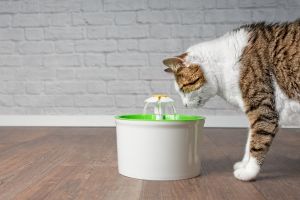As one of the hottest months of the year, July is a time when you need to stay hydrated. The media blasts messages at this time of year reminding us to drink plenty of water to prevent dehydration and heat-related illnesses. Unfortunately, there is not as much information on how important proper hydration is for optimal health in cat and dog nutrition.
To help pet parents better understand their companions' needs, PetSafe established National Pet Hydration Awareness Month. This event takes place each July and aims to educate pet owners about how crucial it is to ensure their dogs and cats drink plenty of water during the summer and throughout the year. As veterinarians, we see far too many cases of dehydration every summer and would like to help you prevent your furry family member from experiencing this all-too-common problem. This post will discuss Pet Hydration Awareness Month and how you can keep your pet well-hydrated and healthy.
The Importance of Keeping Pets Hydrated
Keeping your pet hydrated is the best way to help them combat those blazing hot July days. While often overlooked, hydration is a crucial component of overall health and well-being in companion animals — just as it is in humans! Dogs' and cats' bodies are made up of roughly 70 percent water, and this water is vital for all bodily processes. From moisturizing the air in their lungs and regulating body temperature to supporting nervous system function and transporting nutrients and oxygen in the bloodstream to cells, water performs countless functions for pets' bodies.
Dehydration is common during hot weather, and it can quickly turn deadly. Keeping your pet's bowl filled with cool, clean water is a crucial step in warding off this problem, but sometimes it isn't enough. In these instances, prompt veterinary care is essential. As a pet parent, it's up to you to keep your four-legged family member well-hydrated and to recognize the early warning signs of dehydration.

Symptoms of Dehydration in Pets
The symptoms of dehydration are similar for both dogs and cats. They even share some symptoms with humans. Recognizing the signs and seeking veterinary care right away could save your pet's life, so we strongly recommend familiarizing yourself with them.
The symptoms of pet dehydration include:
- Lethargy
- Reduced energy
- Loss of appetite
- Heavy panting
- Dry gums and nose
- Sunken eyes
- Decreased skin elasticity (skin tenting)
- Vomiting
- Constipation or very hard stools
In cats, insufficient water intake can also cause urinary blockages, which can be fatal when not treated immediately.
The symptoms of feline urinary blockages include:
- Howling/crying
- Straining in the litter box and producing little to no urine
- Litter box avoidance
- Hiding
- Excessive grooming or licking of the genitals or the area below the base of the tail

Keeping Your Pet Well-Hydrated
There are several ways to help your pet stay healthy and hydrated on even the hottest days of the year. Here are a few tips: Provide 'Round-the-Clock Access to Water Pets need unrestricted access to clean, fresh water at all times. If your pet spends time indoors and outdoors, ensure they have water in both locations. Take some with you when going for walks and when traveling with your pets.
Switch to Wet Food
Switching to wet food could help your pet stay hydrated if they aren't drinking enough water. Wet food has a significantly higher moisture content than dry, so it's an excellent way to help your furry friend get the hydration they need. Since cats tend not to drink enough water, offering them wet food is extremely important.
Move the Water Bowl If Your Pet Isn't Drinking
Animals — especially cats — are often finicky about the location of their water bowl. They may refuse to drink if you place it too close to their litter box, food, or a noisy appliance such as a washing machine. Some dogs instinctively refuse water when the bowl is in the wrong place, too. If your pet doesn't seem interested in their water bowl, move it to a clean area away from food dishes and litter boxes. Make sure it's in a convenient location to allow easy access.

Try a Different Bowl Type
Just like children often have a favorite cup and refuse to drink out of anything else, pets might not drink if they don't like their bowl. Experiment with different styles if your dog or cat avoids their current water bowl.
Some pets prefer recirculated water fountains over traditional bowls. They keep the water moving, and animals' instincts tell them that moving water is safer than still water. Even the pickiest felines may get over their water aversion once they have access to a moving water source. Be sure to wash the bowl regularly with hot soapy water to prevent mildew from forming, making the bowl as pleasing as possible.
Limit Exercise and Outside Time on Hot Days
Pets (and people) are more susceptible to dehydration on hot, sunny days. Protect your furry friend by keeping them indoors and limiting physical activity when the temperature soars. A 90-degree day is not the time for a rollicking game of fetch in the backyard! And, of course, you should never leave your pet in an unattended vehicle on a hot day.
Closing Thoughts
Keeping your dog or cat well-hydrated is a crucial step in maintaining their health and avoiding dehydration and heatstroke. If you have additional questions or think your pet may not be getting enough water, we're here to help. Contact us today to schedule an appointment and learn more about keeping your furry friend hydrated all summer.

